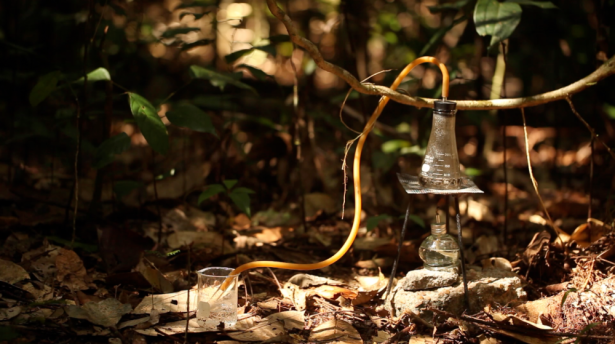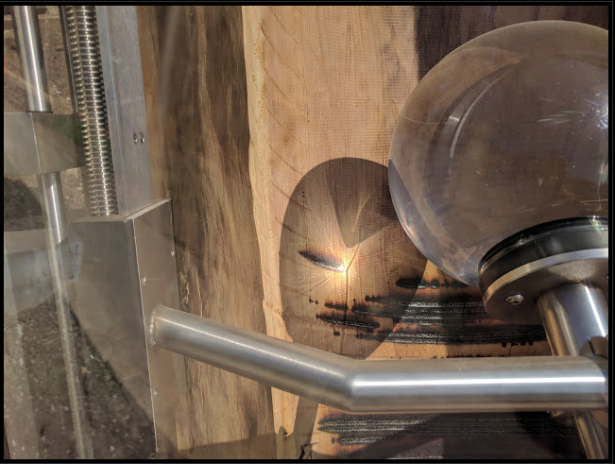This post comes from the Artists and Climate Change Blog
“Art is about what has touched us in the world.â€Â —Maurice Merleau-Ponty
I am passionate about using art to facilitate thinking about our place in the world, whether this be exploring our connection to the past, and /or to what is happening here and now. I draw from various interests – anthropology, history, oceanography, and various environmental issues. Earth’s story along with our changing climate are important and constant threads through my work. They help me connect to something beyond the self.
Our impact on the environment, and the subsequent changing climate, is one of the most pressing issues of our time. We are constantly surrounded by news and data – shocking headlines grab attention and large corporate organizations hold sway. We now have scientific evidence and knowledge on an unprecedented scale, information which tells us how our actions are directly affecting life on this planet. At times this can seem overwhelming, leading to feeling powerless, and desensitizing us to these important issues.
For me, the challenge we face is to stay empowered and engaged in the face of so much worrying information.
I try to channel my concerns into my art practice. I predominately work with the book form, creating unique artist books which celebrate the dynamic beauty of the natural world. I hope to inspire, and remind people of what we have, and what we stand to lose if we do not pay heed. I aim to make work which invites people to “step closer†rather than away, holding the belief that if we love something we are more likely to want to protect it. I see art as the beginnings of a conversation. A conversation that can occur on many levels – between the past, the present, and the future. Conversations provide space to reflect and the potential for something new to come into existence.
Collaborations between scientists and artists offer a myriad of ways to engage audiences, and have enormous potential to further raise awareness of environmental concerns. All change starts with a small action – we need not be powerless. While we may be unable to travel the world to witness what is occurring firsthand, the benefit of living in an era of information means freer access to scientific research, films and books – all important sources which facilitate dialogue, and transport us to the largely inaccessible extremes of our world.
Books, with their sequence of spaces, give scope for work to take you on a journey of discovery. It does not have to involve a linear narrative – various book structures offer diversions and alternative paths, where the viewer dictates the direction and pace. Holding a book and navigating its pages is an interactive experience between artist and viewer. The experience of holding a handmade book delights more than the mind. It can be an intimate, sensory experience – of touch and texture, providing reflection on a “moment of time.†There is not necessarily a beginning or an end, for it can be a cyclical process.
I use the book format in its widest sense, sometimes using traditional bindings alongside more sculptural pieces, where the book becomes an object in its own right. From early childhood books have always held a special place in my life; I have early memories of delving into the Encyclopaedia Britannica for homework projects, and visiting libraries after school. It is no surprise that books continue to feature in my art practice. I enjoy reading and often gain inspiration from the shared knowledge of others. The wealth of accessible science books now available to the general reader makes the complex more tangible, and allows entry into areas that often spark ideas for my work.
I am a frequent visitor to museums. The Great Gathering, a series of seven ammonite-shaped books, evolved from initially visiting the Sedgwick Museum of Science, Cambridge and then Colchester Natural History Museum.
The Great GatheringÂ
Responding to both the building and museum collection, this series of seven artist books tells the story of the universe spanning 650 million years. Fossil collections have been key to unlocking our understanding of evolution. Echoing the spiral shape of an ammonite, each book reflects a significant moment of this journey. From dark beginnings (black holes), the Big Bang, forming oceans, ancient sediment layers, Darwin’s On the Origin of Species, to the twentieth century and the age of knowledge (recycled National Geographic Magazines), the work charts the inevitability of change. The seventh volume remains unfinished and is in the process of becoming; it represents an unknown future which is still unfolding. The installation was displayed at the Colchester Natural History Museum for three months in 2016 and is now in a private collection.
Ripples Held in a Slumber of Blue
I have a particular interest in the polar regions and in what is happening with the world’s glaciers. This fragile environment is rapidly changing. Having followed the work of James Balog and the Extreme Ice Survey, I produced a series of artist books about this disappearing world. A world which holds our ancient history; once dissolved it can never be replaced.
The Reports of Seasoned Observers – Silent Spring RevisitedÂ
The year 2012 marked the fiftieth anniversary of the publication of Rachel Carson’s Silent Spring. I spent a number of weeks at Southend Museum viewing their egg collections. Following discussions with the curators, I was made aware of the contentious issue surrounding the display of these old collections. Attitudes have changed in the past fifty years; it is now illegal to remove any egg from a nest. Conversely these collections have a vital role in helping scientists to compare, for example, the thickness of shells from the past and now. Shells now are often thinner than they use to be.
I created a series of “fossilized†eggs, vessels carrying Carson’s own words, reminding us of the continued relevance of her research and highlighting the worrying decline of bird and insect species today. The egg, often seen as a symbol of renewal, in this instance becomes a reminder of loss.
Lost Voices
Lost Voices is a series of artist books, which explore the complex relationship between humans and whales over the past two hundred years. Taking visual inspiration from the old whaling logbooks, I incorporated passages from Melville’s Moby Dick, as well as first-hand accounts to capture the “lost voices†from this period of history. The original whaling documents are of a great value to climate scientists, who are able to use the data regarding old weather patterns and compare them to now.
(Top image:Â The Great Gathering, Vol.V The Age Of Transition.)
______________________________
Chris Ruston has a Fine Art background, and worked as an art psychotherapist for many years. She particularly enjoys working with paper, inks and mark making. She regularly takes part in Artist Book Fairs and has been featured in several book art publications. She received the Artist Award at Turn the Page, Artist Book Fair, Norwich in 2015.
Artists and Climate Change:
Artists and Climate Change is a blog that tracks artistic responses from all disciplines to the problem of climate change. It is both a study about what is being done, and a resource for anyone interested in the subject. Art has the power to reframe the conversation about our environmental crisis so it is inclusive, constructive, and conducive to action. Art can, and should, shape our values and behavior so we are better equipped to face the formidable challenge in front of us.





















